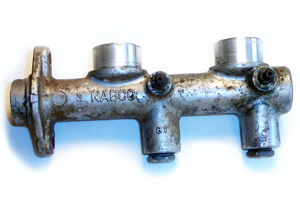 Although the mechanics of modern master cylinders seem deceptively simple, today’s dual-piston or tandem master cylinders still require the utmost in care and attention to maintain safe, reliable operation.
Although the mechanics of modern master cylinders seem deceptively simple, today’s dual-piston or tandem master cylinders still require the utmost in care and attention to maintain safe, reliable operation.
The most important point to remember during any master cylinder diagnosis is that an inch of travel at the brake pedal translates into only a few thousandths of an inch of piston travel at a disc brake caliper or brake cylinder. Consequently, the fluid displacement of a master cylinder is matched very closely to the fluid volume requirements of the brake system itself. Obviously, the clearance between a brake pad and rotor may drastically affect master cylinder operation. Some caliper applications use a square-cut piston seal to retract the piston a few thousandths of an inch when the brakes are released. Some caliper applications may require a “quick-take-up” cylinder to close these relatively large pad-to-rotor clearances as the brake pedal is applied.
Failure Patterns
As the piston seals wear or the cylinder bore becomes scuffed or pitted, piston seal leaks cause a falling or spongy feel in the brake pedal. The falling pedal symptom is caused by fluid leaking from the brake hydraulic system into the atmosphere or by fluid leaking internally around the piston seals.
A spongy brake pedal can occasionally be attributed to a master cylinder with a worn rear seal. In these cases, air enters the cylinder as the pedal is released and is sometimes pumped into the hydraulic system.
A worn rear seal will also allow brake fluid to mysteriously disappear from the master cylinder reservoir into the vacuum brake booster and ultimately into the engine intake itself. One indicator of this condition, of course, is fluid consumption without evidence of external leakage. Another indicator is a wet area forming around the mounting flanges of the master cylinder.
Diagnostics
Brake pedal feel is often vehicle-specific because some vehicles allow for a longer length of brake pedal travel than others. In general, a good master cylinder should provide a positive, controlled sense of braking. A falling, spongy or low pedal, on the other hand, indicates a problem with the master cylinder or the brake system hydraulics.
A worn master cylinder might be detected by gradually applying pressure to the brake pedal with the engine running to provide assist. If the lip seals in the cylinder are excessively worn, the pedal may sink completely to the floor during a gradual application.
Occasionally, a newly installed master cylinder will fail to release pressure from the brake hydraulic system and cause the brakes to either lock up or drag. In these cases, the forward lip seal has failed to retract past the compensator port due to a faulty adjustment on the brake booster push rod, or a bad adjustment of the brake light or cruise control vacuum brake switch on the brake pedal lever. A quick way to test for piston retraction is to gently probe through the compensating port with the blunt end of a paperclip. If the cylinder has an open-top reservoir, depressing the brake pedal should cause fluid to spurt from a momentarily open compensator port. Some master cylinders are very aggressive in this regard.













